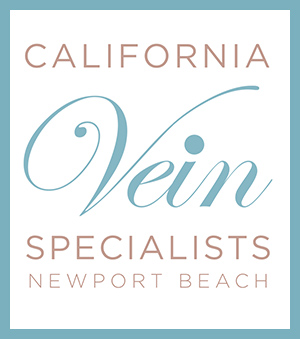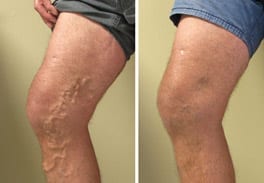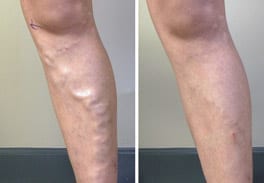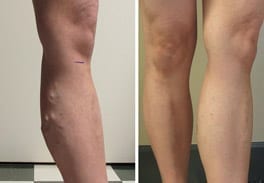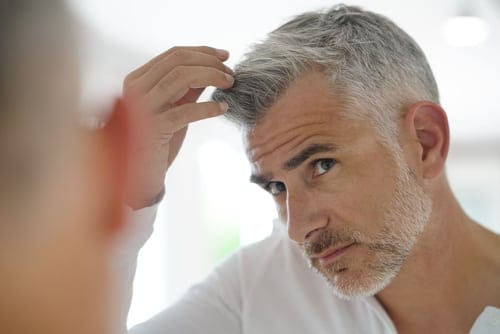
Have you noticed more hair on your brush or pillow than usual? Are you tired of watching your hair thin out day by day? Millions of men and women face the challenge of hair loss, feeling helpless as their appearance—and confidence—slowly slip away.
But what if there were a natural, effective way to combat thinning hair and baldness, and restore your hair's vitality? PRP Hair Restoration might be the answer you've been searching for.
PRP Hair Restoration harnesses your body's own healing power to revitalize your hair follicles and promote new growth. This minimally invasive procedure has risen in popularity due to its effectiveness, safety and the natural results it provides. Our expert team at California Vein Specialists has helped countless individuals just like you overcome hair loss and rediscover their confidence.
Request a consultation to find out if PRP Hair Restoration in Newport Beach could be the perfect solution for you.
What Is PRP Hair Restoration?
For many men and women alike, thinning hair is an inevitable result of aging. Hair loss is also an unfortunate side effect of stress, hormonal changes and certain medical conditions.
While hair thinning is more common in men, this condition also affects numerous women. Approximately 50 million men and 30 million women in the United States have male-pattern and female-pattern baldness, respectively. As many as 65 percent of men and 45 percent of women affected start to notice a loss of hair by the age of 50. These trends make hair restoration one of the most popular types of cosmetic enhancement.
First developed as a treatment for pain-related musculoskeletal conditions, platelet-rich plasma (PRP) therapy has also proven effective in reversing hair loss. PRP uses the growth factors found in the patient’s blood plasma to help restore the scalp’s natural hair growth processes. This approach is particularly effective when hair loss develops as a result of the cells and blood vessels within the scalp becoming less active with age.
How Does It Work?
PRP therapy is a sophisticated yet straightforward treatment. The process begins with a small blood draw, typically from your arm. The blood is then situated in a centrifuge, where it is spun at high speeds to separate the PRP from other blood components. The concentrated PRP is rich in growth factors and carefully injected into the areas of your scalp experiencing hair thinning or loss.
What makes PRP so unique is its use of your own biological material. Concentrating the healing factors already present in your blood allows us to provide a completely natural treatment for hair loss. It’s your body’s own regenerative power, amplified and applied precisely where you need it most.
How Do Growth Factors in PRP Treat Hair Loss?
If you’re familiar with blood platelets, you may know that they play a crucial role in clotting. But their benefits do not stop there.
Your blood also contains a vital component called growth factors. Growth factors work throughout your body, repairing and regenerating your cells and tissues.
When we inject blood plasma with concentrated platelets and growth factors into the areas of your scalp with thinning hair, these same growth factors increase blood supply in the area and stimulate your scalp’s repair and regeneration processes. This creates a healthy environment for natural hair growth to resume.
Over the following weeks and months, the treated areas continue to benefit from the growth factors. This leads to improved hair density, thickness, and overall hair quality.
How Does PRP Stimulate the Hair Growth Cycle?
A healthy human scalp contains approximately 100,000 hair follicles, with each follicle growing 20 individual hairs within a person’s lifetime. Hair growth and hair loss follow a cycle that maintains a certain number of hairs on the head when this cycle is healthy. Considering that the scalp loses around 100 strands a day on average, it’s easy to see how hair loss occurs when the effects of aging take hold.
What Are the Three Stages of Hair Growth?
Each hair follicle goes through three growth phases:
- The anagen phase
- The catagen phase
- The telogen phase
Actual hair growth occurs during the anagen phase, which lasts anywhere from three to five years. Platelet-rich plasma therapy jumpstarts the hair growth cycle by prolonging the growth portion of the anagen process. In effect, the growth factors contained in the platelets work to repair aging hair follicles and increase hair growth rates.
The catagen phase marks the second stage of the growth cycle and lasts for two to three weeks. This stage acts as a transitional period when hair follicles develop roots in the scalp.
The telogen phase marks a resting stage that lasts for three to four months. At the end of the telogen phase, the follicle sheds the hair.
Benefits of PRP Hair Restoration
- Natural Growth: PRP uses your body’s own cells, reducing the risk of adverse reactions and promoting natural hair growth.
- Nonsurgical Solution: Invasive procedures, and the incisions and downtime that come with them, are not for everyone. PRP is minimally invasive with no incisions.
- Quick and Convenient: With sessions typically lasting about an hour, you can fit treatment into your busy schedule.
- Effective: Many of our patients notice an improvement in hair density and thickness within a few months.
Ready to take the first step towards fuller hair? Contact us to learn how PRP can work for you.
Ideal Candidates for PRP Hair Restoration
Who Can Benefit?
PRP Hair Restoration suits both men and women experiencing hair thinning or loss. It is particularly successful for those in the early stages of hair loss and for individuals who are not candidates for surgical hair restoration.
Some of the conditions we can address with PRP include:
- Androgenetic Alopecia: the most common cause of hair loss in men and women.
- Alopecia Areata: an autoimmune condition that results in patchy hair loss.
- Telogen Effluvium: temporary hair thinning often triggered by stress or hormonal changes.
If you meet the following conditions, you’re more than likely a good candidate for platelet-rich plasma hair therapy:
- You’re in good health
- You are experiencing the early stages of hair loss
- You are not taking blood-thinning medications
- Your hair has only recently started to thin out
Commonly Treated Areas
- Scalp: increases hair density, thickness and strength in thinning areas.
- Eyebrows: enhances fullness and shape, providing a more youthful appearance.
- Beard: promotes even growth, addressing patchiness and improving overall beard density.
Who Is Not a Good Candidate for PRP Hair Restoration?
Hair growth in any form relies on healthy blood vessels and healthy blood circulation in the scalp. When one of these conditions is lacking, PRP will produce limited results at best.
You may not be a candidate for PRP hair restoration treatment if one or more of the following applies to you:
- You take blood-thinning medication
- You smoke heavily
- You have a low platelet count
- You’ve been diagnosed with sepsis
- You’ve been diagnosed with cancer
- You have an acute or chronic infection
- You have thyroid disease
- You have a chronic skin or liver disease
- You have hemodynamic instability
- You have hypofibrinogenemia
- You have platelet dysfunction syndromes
At your consultation, we will evaluate your medical history, current medications and other factors that may affect your eligibility for PRP hair restoration treatment to ensure you are a good candidate before moving forward.
Customization for Different Needs
Each treatment plan is designed to the patient’s specific needs and goals. Whether you’re dealing with male-pattern baldness, female-pattern hair loss or general thinning, PRP can be customized to target your unique concerns. We pride ourselves on delivering impeccable and personalized care.
Average Treatment Timelines and Results
Typical Treatment Plan
Platelet-rich plasma hair restoration injections are a nonsurgical, in-office procedure that takes less than an hour to complete.
Step 1: A Simple Blood Draw
The process starts by drawing blood from your arm to gather the platelet material. This is similar to a routine blood test and is usually quick and comfortable.
Step 2: Purifying and Concentrating Your Blood Plasma
Next, a device that spins, called a centrifuge, is used to separate the red blood cells from the plasma. This machine uses centrifugal force to separate the red blood cells and platelet-poor plasma from the platelet-rich plasma.
To ensure a high platelet concentration, a hematology analyzer device is used to analyze a sample of the platelet-rich plasma. The high-quality PRP is then put into syringes.
Step 3: Antiseptic and Anesthetic Application
The medical assistant then applies an antiseptic solution and anesthetic to your scalp to guard against infection and numb the scalp’s surface. The use of this medication creates a nearly painless procedure.
Step 4: Injecting the PRP in Areas With Hair Loss
Once the scalp is prepared, a high concentration of platelet-rich plasma will be injected into the areas that have thinning hair. Injections are made at half-inch intervals over the treated area so the platelets can enter the scalp at the follicle level.
Immediate and Long-Term Results
Once injected, the growth factors in the PRP get to work. They encourage new hair growth in several ways:
- Increasing blood supply to the follicles
- Prolonging the growth phase of the hair cycle
- Stimulating dormant follicles to become active
- Increasing the size of hair follicles, leading to thicker hair strands
While some patients notice improvement after the first treatment, the most significant results are seen three to six months after the final session. Long-term benefits include sustained hair growth and improved hair health.
Maintenance Tips
To maintain your results, follow-up treatments every six to twelve months are recommended. Additionally, employing a healthy hair care routine and managing stress can help sustain the benefits of your PRP treatment.
Downtime and Recovery
What Is PRP Recovery Like?
After your PRP treatment, you do not need to plan for any downtime; you can resume most of your daily activities immediately. However, we recommend taking it easy for the rest of the day and being aware of any activity restrictions your provider suggests.
As the hair follicles respond to the platelet-rich plasma, a decrease in hair shedding will be the first thing you’ll notice. Before long, new hair will start to grow, and existing strands will grow longer. On average, you can expect to see noticeably fuller and longer hair within two to three months.
Possible Side Effects
PRP Hair Restoration is a procedure with very few side effects. Some patients may experience mild scalp tenderness, redness or slight swelling at the injection sites, but these symptoms typically resolve within a few days.
Post-Treatment Care
Following these recommendations will help you achieve the best PRP hair restoration results possible:
- Avoid Washing Your Hair: Wait to wash your hair for at least 24 hours post-treatment.
- Limit Sun Exposure: Protect your scalp from direct sunlight for a few days.
- Avoid Strenuous Activity: Refrain from intense exercise for a day or two.
- Refrain from Smoking/Drinking: Do not smoke or drink alcohol for three days.
Comparing PRP Hair Restoration vs. Alternative Treatments
Today, you have many options for addressing hair loss. Most can be effective under the right circumstances, but not every treatment is the right fit for every patient.
PRP Hair Restoration
- Natural and minimally invasive
- Uses your own blood components
- Minimal downtime
- Results typically visible within 3-6 months
- May require maintenance treatments
Medications (Minoxidil and Finasteride)
- Topical or oral options available
- Requires daily, consistent use
- Can be effective, especially in early stages of hair loss
- Potential side effects (e.g., scalp irritation, sexual dysfunction)
- Results may diminish if treatment is discontinued
Hair Transplants
- Surgical procedure with permanent results
- Longer recovery time (1-2 weeks)
- Higher upfront cost
- Can achieve dramatic results, especially for advanced hair loss
- Risk of complications associated with surgery
Laser Therapy
- Noninvasive, painless treatment
- Requires regular sessions (often weekly)
- Results may take longer to become noticeable
- Effectiveness can vary widely between individuals
- Often used in combination with other treatments
Choosing the Right Hair Restoration Method for You
PRP Hair Restoration offers a unique balance of benefits:
- It’s a natural approach that harnesses your body’s own healing capabilities.
- The treatment is quick, with minimal downtime, making it suitable for busy lifestyles.
- It can be effective for both men and women, and at various stages of hair loss.
- There’s lower risk of side effects compared to medications or surgery.
However, the best choice for you will depend on your individual circumstances. At California Vein Specialists, we offer personalized consultations to assess your specific situation and recommend a suitable treatment plan. Our goal is to help you achieve the best possible results while considering your preferences, lifestyle and overall health.
Frequently Asked Questions About PRP for Hair Loss
What is the cost of PRP hair restoration in Newport Beach?
At California Vein Specialists, we offer a package of four PRP hair restoration treatments for $2,900. If you choose not to get the package, we offer treatments at the cost of $750 per two tubes. For those who would like more injections, extra tubes are available for $150 each.
The total price of your treatment will depend on your individual circumstances and concerns, the size of your treatment area and various other factors. After your personalized PRP consultation, we will be able to provide you with the specific cost of your PRP hair restoration treatments.
How long does the PRP procedure take?
The entire PRP procedure typically takes about an hour, including preparation and post-treatment care. The actual injection process is relatively quick, usually around 30 minutes, but this can differ based on the size of the treatment area.
Is PRP therapy painful?
The blood draw portion of PRP treatment is equivalent to a simple blood draw you might get at the doctor’s office for testing or when donating blood. You may feel a slight prick at the donor site in your arm where the small needle is inserted, but patients say this is relatively comfortable or only creates slight discomfort.
While you may feel mild pressure during the PRP injection process, it is generally reported to involve minimal discomfort. A numbing solution is used before the injections.
Recovery is generally painless as well, but an over-the-counter pain reliever should minimize any discomfort you might experience after your appointment.
When should I start PRP?
Platelet-rich plasma hair restoration injections produce the most favorable results when treatment is administered at the first signs of hair loss. If you’ve noticed developing patches of thinning hair, now is the time to look into PRP therapy.
How many PRP treatments are needed?
The number of treatments varies depending on each client’s unique needs and the extent of hair loss. Most patients benefit from a series of three to four treatments spaced four to six weeks apart. Maintenance treatments every six months to a year are often recommended to sustain results.
When will I see PRP results?
Initial improvements may be noticed within two to three months, with more significant results appearing after six months. Hair growth and thickness continue to improve with subsequent treatments.
Are PRP results permanent?
PRP therapy stimulates natural hair growth, but maintenance treatments may be needed to sustain the results over time. Hair growth cycles and individual responses to treatment can vary, so ongoing maintenance may be necessary to maintain optimal results.
Who is an ideal candidate for PRP therapy?
The perfect candidates for PRP are those in the early stages of hair loss with active hair follicles that can respond to the growth factors in PRP. It is suitable for both men and women and is most effective for those with androgenetic alopecia (pattern baldness). A thorough consultation with a specialist is important in determining candidacy.
What are the potential side effects of PRP?
Risks are a concern for patients with any procedure, but the good news is the risks associated with PRP therapy are relatively minimal. These rare but potential risks include scarring, injection, calcium buildup in the scalp and injury to nerves or blood vessels. Since platelet-rich plasma therapy uses the patient’s blood, there’s no risk for allergic reactions or adverse effects.
PRP side effects are also rare but may include irritation or aches in the treated area, inflammation, skin discoloration, dizziness and nausea.
Our staff will take steps to minimize any risks and ensure your safety and comfort throughout the procedure. They will review the benefits and risks of PRP and answer any questions you may have before, during and after treatment.
Can PRP be combined with other hair loss treatments?
Yes, PRP therapy can be combined with other hair loss treatments, such as topical minoxidil, oral finasteride, or low-level laser therapy, to enhance results. Discussing a comprehensive treatment plan with your specialist can help maximize the effectiveness of your hair restoration efforts.
How does PRP compare to hair transplant surgery?
PRP is a nonsurgical treatment that stimulates natural hair growth, making it less invasive with minimal downtime compared to hair transplant surgery. While hair transplant surgery provides permanent results by moving hair follicles from one area of the scalp to another, PRP is a more gradual approach that enhances existing hair follicles. The best option depends on the individual’s condition and preferences.
What should I do before and after the PRP procedure?
Before the procedure, it’s recommended to avoid blood-thinning medications and supplements to reduce the risk of bruising. Staying hydrated is also important. After the procedure, avoid washing your hair for 24 hours, and follow any specific aftercare instructions provided by your specialist to optimize results and minimize any side effects.
How does PRP therapy work for different types of hair loss?
PRP therapy is particularly effective for androgenetic alopecia. Still, it can also benefit individuals with other types of hair loss, such as traction alopecia or hair thinning due to stress or medical conditions. The effectiveness can vary based on the cause and extent of hair loss, making a thorough consultation essential for tailoring the treatment to individual needs.
Is PRP therapy covered by insurance?
PRP therapy for hair restoration is typically considered a cosmetic procedure and is not covered by most insurance plans. However, many clinics, including California Vein Specialists, offer financial options to make the treatment more accessible.
Can PRP therapy be used alongside other aesthetic treatments?
Yes, PRP therapy can be combined with other aesthetic treatments, such as microneedling or laser therapy, for enhanced results. Combining treatments can help address multiple aspects of hair loss and skin rejuvenation, providing a more comprehensive approach to aesthetic improvement.
Can PRP therapy help with other conditions besides hair loss?
PRP therapy is also used in various medical fields for its regenerative properties. It can be beneficial for conditions such as joint pain, tendon injuries and skin rejuvenation. The principles of PRP therapy in promoting tissue repair and regeneration make it a versatile treatment option beyond hair restoration.
What should I look for in a PRP therapy provider?
Choosing a qualified and experienced provider is crucial for the success of your PRP therapy. Look for a clinic with positive patient reviews, a proven track record, and board-certified specialists trained in PRP procedures. A thorough consultation and a personalized treatment plan are also indicators of a reputable provider.
What is male-pattern baldness?
Male-pattern baldness, also known as androgenic alopecia, is a condition in which men slowly lose hair from their scalp. It tends to start as a receding hairline above the forehead or a bald spot at the crown of the head. This type of permanent hair loss is often genetic and results in complete baldness as men age. PRP therapy can be an effective treatment for male-pattern baldness.
What is female-pattern baldness?
Female-pattern baldness is a genetic condition in which women experience overall thinning of their hair while typically maintaining their natural hairline. They may notice that the part in their hair reveals more of their scalp than it did when they were younger, and their hair continues to become thinner over time. PRP therapy can be an effective treatment for female-pattern baldness.
Take the Next Step with California Vein Specialists in Newport Beach
If you’re ready to take the next step toward fuller, healthier hair, consider PRP Hair Restoration at California Vein Specialists. Our team of experts is dedicated to providing personalized care and helping you achieve the best possible results.
At our Newport Beach office, our experienced staff will be happy to walk you through each stage of the treatment process and answer any questions you may have. Call our office at 949-515-9377 to schedule a consultation and see if PRP therapy is right for you.
*Providing you with accurate medical information is one of our priorities. To ensure this, Dr. Leary reviews all the information posted on our website. Please get in touch with us today if you would like more information about any of the conditions we treat and the procedures we offer.
